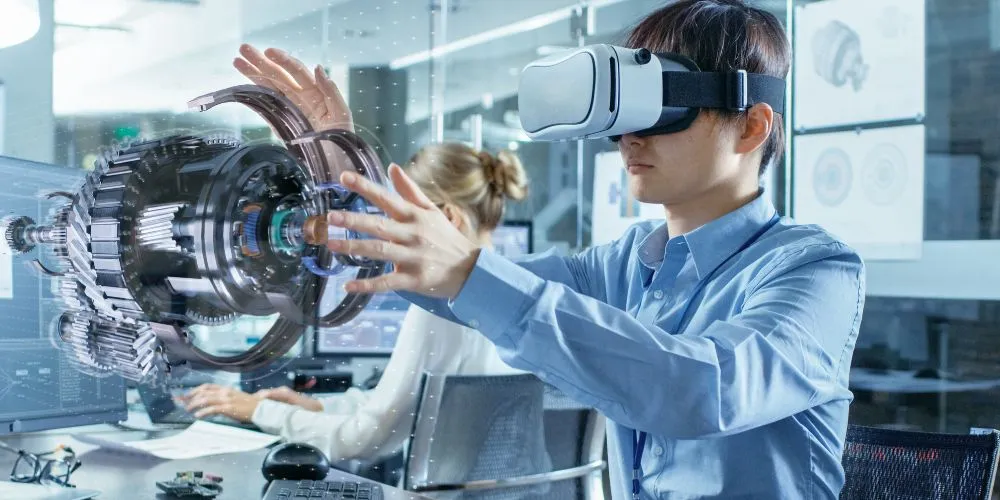Virtual Reality (VR) technology has emerged as a revolutionary force, transforming how individuals interact with digital environments and content. This article conducts a thorough analysis of the present state of the VR market, exploring key trends, market dynamics, and challenges and offering insights into the future outlook of this dynamic sector.
Market Overview
Virtual Reality (VR) technology immerses users in simulated environments, providing an interactive, immersive experience that blurs the line between the physical and digital worlds. The global Virtual Reality market is witnessing rapid growth, driven by advancements in hardware, software, and content creation, as well as increasing applications across various industries.
Key Market Trends
Several influential trends are shaping the Virtual Reality market, indicating the transformative potential of immersive technology:
Expansion Across Industries
Virtual Reality expands its footprint across diverse industries, including gaming, entertainment, healthcare, education, and enterprise. In gaming and entertainment, VR offers immersive gaming experiences and interactive storytelling. In healthcare, it facilitates medical training, patient rehabilitation, and therapy. In education, VR enables experiential learning environments, while in enterprise, it enhances training, collaboration, and visualization.
Advancements in Hardware and Software
The market is witnessing significant advancements in VR hardware and software. Innovations like standalone VR headsets, haptic feedback devices, and eye-tracking technology enhance the immersive experience. Meanwhile, software developers create compelling VR content, from games and simulations to training programs and virtual tours.
Adoption of Augmented Reality (AR) and Mixed Reality (MR)
The adoption of Augmented Reality (AR) and Mixed Reality (MR) is gaining momentum alongside VR. AR overlays digital information onto the real-world environment, while MR combines virtual and physical elements to create immersive experiences. These technologies complement VR and offer new possibilities for interactive content and applications.
Enterprise Applications and Training
Virtual Reality is increasingly utilized for enterprise applications, particularly in training and simulation. Manufacturing, automotive, aerospace, and defense industries leverage VR for employee training, safety simulations, product design, and prototyping. VR-based training programs offer a cost-effective and immersive alternative to traditional methods.
Challenges
Despite the positive trends, the Virtual Reality market faces certain challenges that impact its widespread adoption and integration:
High Cost of Entry
The high cost of VR hardware and software remains a barrier to access for many consumers and businesses. Premium VR experiences often require expensive headsets and powerful computing systems, limiting accessibility and adoption, particularly in price-sensitive markets.
Content Fragmentation
The VR content ecosystem is fragmented across various platforms and devices, leading to compatibility issues and fragmentation. Developers must navigate multiple distribution channels and hardware specifications, hindering the seamless delivery of VR content to users across different platforms.
Motion Sickness and User Comfort
Motion sickness and discomfort are common challenges associated with VR experiences. Some users may experience nausea, dizziness, or eye strain when using VR headsets for extended periods. Addressing these issues requires ongoing research and development efforts to improve comfort and reduce the risk of adverse effects.
Future Outlook
The Virtual Reality market holds several key developments for the future, shaping the evolution of immersive technology and digital experiences:
Convergence with Augmented Reality (AR)
The convergence of Virtual Reality with Augmented Reality (AR) is expected to accelerate, blurring the boundaries between virtual and physical worlds. This convergence will lead to developing Mixed Reality (MR) experiences seamlessly integrating digital content with real-world environments, unlocking new opportunities for interactive applications.
Enterprise Adoption for Remote Work and Collaboration
Virtual Reality will play an increasingly significant role in remote work and collaboration, particularly in a post-pandemic world. VR technology offers immersive meeting spaces, virtual offices, and collaborative environments that enable remote teams to interact and collaborate as if they were in the same physical location.
Continued Innovation in Hardware and Content
Innovation in VR hardware and content will drive the market forward, with advancements in display technology, tracking systems, and user interfaces enhancing the immersive experience. Content creators will continue to push the boundaries of storytelling, gaming, and interactive experiences, catering to diverse audiences and applications.
Conclusion
Virtual Reality technology is poised to revolutionize how individuals interact with digital content and environments. As the Virtual Reality market evolves, addressing challenges related to cost, content fragmentation, and user comfort will be pivotal. The future outlook is optimistic, with Virtual Reality set to become increasingly integrated into various industries, offering immersive experiences, training solutions, and collaborative environments that redefine how we work, learn, and interact in the digital age. Virtual Reality is not just a technology but a gateway to new realities and endless possibilities for innovation and creativity.










